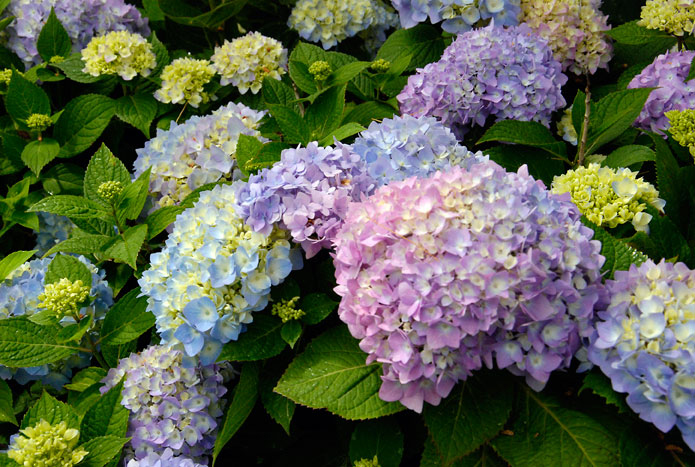 Hydrangeas are one of the most popular plants in today’s landscape. They change everything in the landscape. A corner garden that was once in need of some color, add a hydrangea and you have instant success. Beautiful landscapes can be achieved with the simple use of a mass of Oakleaf hydrangeas underneath an allee of trees. A small group of three Original Endless Summer hydrangeas that shine bright blue all summer long provide easy success.
Hydrangeas are one of the most popular plants in today’s landscape. They change everything in the landscape. A corner garden that was once in need of some color, add a hydrangea and you have instant success. Beautiful landscapes can be achieved with the simple use of a mass of Oakleaf hydrangeas underneath an allee of trees. A small group of three Original Endless Summer hydrangeas that shine bright blue all summer long provide easy success.
Here are a few things to keep in mind when growing and caring for the Wonderful World of Hydrangeas:
- WATER
- When purchasing a hydrangea buy a soaker hose with a timer.
- This will decrease the time you spend watering the hydrangea to establish the plant
- Guarantees a deep and thorough soaking
- When purchasing a hydrangea buy a soaker hose with a timer.
- A good 45 minute deep and thorough soaking a few times a week depending on temperatures is recommended
- The higher the temps, the more water needed
- If you only want to water a small group, use another non-soaker hose to get to where you need
- The important thing to remember is that you will always need to water regardless of type of plant.
- It often comes down to how long and how often you water
- If the leaves are drooping and look tired that’s because they require more water
- If the tips of the leaves are brown it was because water was not given in time
- You can save the plant with a deep, thorough soaking
- Water stress will generally show in late afternoon when the sun is at its hottest
- Starter Products
- Not all fertilizers were created equal:
- Holganix Bloom is recommended to establish your hydrangeas
- Yucca extract is included to reduce watering times
- Not a fertilizer!
- Beneficial bacteria and fungi for speedier rooting and establishing
- More vivacious blooms, you’ll see the difference
- Use this three times throughout the growing season to see best results
- Holganix Bloom is recommended to establish your hydrangeas
- How do I change the color of my hydrangea?
- Some colors can be changed by adjusting pH
- pH is a scale from 1 to 14 (1 being the most acid to 14 being the most alkaline)
- Not all fertilizers were created equal:
- An good average soil pH is from 6.0 to 6.5 (which is closer to neutral than acidic)
- Our New England soils are usually around a 5.0-5.5 (which is great for evergreens)
- Blue changes to pink with lime (or lime-based products)
- Pink changes to Blue with sulfur based products (Also Aluminum Sulfate)
- White fades to Pink or shades of red, but can never be reversed
- Red can change to Purple (most of the time or a shade of it)
- When using these products it’s important to remember not to use them the first year of planting
- The sulfur and lime can deter the plant from a healthy establishment time
- When do I prune my Hydrangea?
- It all depends on the variety
- Keep records on what you purchase
- This will help you know how to prune your plants and problems that arise with certain types
- Most of the new varieties on the market today can be pruned on either old or new wood
- Check the labels on the plant
- Brands like Proven Winners (PW White Pot) or Monrovia (the green pot) have all the information you need right on their branded tags
- Endless Summer Hydrangeas are best pruned in the Fall
- But you can do it in the early spring because they bloom on old or new wood
- Don’t prune until they are at least 3-4 years of age to allow them to branch out
- A radical idea in the first year is to prune off at least 1-2 sets of buds to allow the plant to root better
- Try out new types of Hydrangeas
- There are multiple types of hydrangeas and there is plenty of different applications for each of them
- Types of Hydrangeas:
- Mopheads
- Original Endless Summer
- Enchantress
- Let’s Dance Moonlight
- Blushing Bride
- Lacecaps
- Twist n’ Shout Endless Summer
- Wedding Gown
- Tuff Stuff
- Blue Billows
- Oakleaf
- Snow Queen
- Munchkin
- Alice
- Late Panicle
- Bobo
- Limelight
- Pinky Winky
- Quickfire
- Michael Dirr’s book Hydrangeas for American Gardens is a great reference for types and care.
- Mopheads
- Check the labels on the plant


